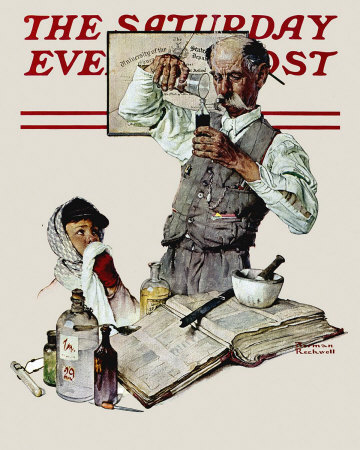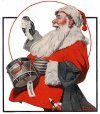 |
||||||||||||||
The Apothecary by Norman Rockwell
March 18, 1939 Issue of The Saturday Evening PostThe Apothecary, a Norman Rockwell painting, appeared on the cover of The Saturday Evening Post published March 18, 1939. This is another favorite of Rockwell collectors, a classic enduring image of the world Rockwell painted. Alternate titles for this painting are Druggist And Boy With A Cold and The Pharmacist. This painting was Rockwell's 185th overall out of 322 total paintings that were published on the cover of the Saturday Evening Post. Rockwell's career with the Post spanned 47 years, from his first cover illustration, Boy With Baby Carriage in 1916 to his last, Portrait of John F. Kennedy, in 1963. This was also the second cover for The Post in 1939. In 1939, there were eight Norman Rockwell Saturday Evening Post covers published. The original oil on canvas painting is part of aprivate collection. This painting also appears in five Rockwell commentary books. It appears:
Pristine original copies of this magazine cover routinely sell for big bucks on eBay, when it is offered. And to think it only cost ten cents originally! And it was mint condition then, too. The ApothecaryGiclee Prints on Archival Paper: In this painting, Norman Rockwell give us a glimpse of a world that has passed by. That world is the world where the local apothecary, (or druggist, pharmacist, call him what you like) would compound your medicine. The compounded prescriptions we dispense are few and far between. Just yesterday, I had two compounded prescriptions for humans that I finished and one for a canine that I could not get around to. Another thing that has changed over the years is that compounding pharmacists are specialists. Most pharmacists do not compound and do not want to make up medicine from ingredients. The pharmacy that compounds will usually have a specialized room or rooms just for that purpose. And we would never dream of whipping up that wonderful medicine right in front of a patient or customer. All that has changed since the days when Rockwell captured this heart-warming scene in this painting. 1939 was indeed a simpler time. The details in this picture, as in all Rockwell compositions, are accurate. The apothecary's diploma is hung proudly on the wall behind his work space. The huge book is called the Pharmacopoei, and it contains all the formulae for all the syrups, ointments, pills, creams, liniments, tonics and rubs that he will make. In this time, the druggist formulated and compounded all day long.. The other paraphrenalia we can see are the mortar and pestle, a spatula, a dropper, a test tube, various bottles, and jugs. He has mixed all the ingredients for the cold medicine into a graduated cylinder and is now pouring his concoction into a dispensing bottle. We cannot tell from our vantage point if he has labeled the bottle yet. The boy is hoping the medicine will make him feel better. But the most pressing question on his mind is whether or not it will taste like medicine. Remember that this was in the day before many synthetic flavors. We do know that the medicine is syrup based. "SP" on one of the bottles indicates that the contents of that bottle are extracted into a syrup. I cannot tell what it is a syrup of, though. That is not visible in the painting. So we, like the boy, have to trust the apothecary to make the right thing in the right way. The Apothecary was only one of 322 Norman Rockwell Saturday Evening Post covers; Here is the list of Norman Rockwell Saturday Evening Post cover illustrations.
Here is the complete list of all Norman Rockwell magazine covers. James K. Van Brunt was the model for the druggist.His signature mustache and face were almost a Rockwell trademark of the period. One other change from that time period til now: no modern pharmacist would be caught smoking a cigar while working. And no patient would buy the medicine if they suspected smoking might affect their medicine.
Norman Rockwell's The Apothecary (1939)
Remember to check back often.
|
Norman Rockwell Quotes:I'll never have enough time to paint all the pictures I'd like to. No man with a conscience can just bat out illustrations. He's got to put all his talent and feeling into them! Some people have been kind enough to call me a fine artist. I've always called myself an illustrator. I'm not sure what the difference is. All I know is that whatever type of work I do, I try to give it my very best. Art has been my life. Right from the beginning, I always strived to capture everything I saw as completely as possible. The secret to so many artists living so long is that every painting is a new adventure. So, you see, they're always looking ahead to something new and exciting. The secret is not to look back. I can take a lot of pats on the back. I love it when I get admiring letters from people. And, of course, I'd love it if the critics would notice me, too. You must first spend some time getting your model to relax. Then you'll get a natural expression. More at BrainyQuote. Rockwell Favorites
|
|||||||||||||
|
|
||||||||||||||
|
Images are copyrighted by their respective copyright holders. Graphic Files Protected by Digimarc. Contact us for details about using our articles on your website. The only requirements are an acknowledgement and a link.
|
||||||||||||||
















